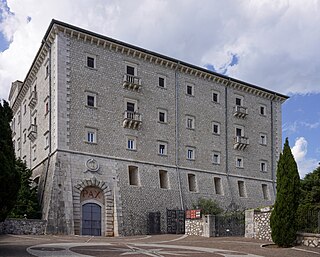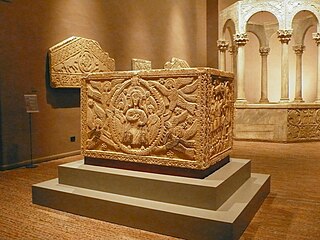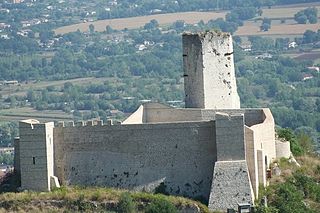Related Research Articles
Pope Stephen IX was the Bishop of Rome and ruler of the Papal States from 3 August 1057 to his death on 29 March 1058. He was a member of the Ardenne-Verdun family, who ruled the Duchy of Lorraine, and started his ecclesiastical career as a canon in Liège. He was invited to Rome by Pope Leo IX, who made him chancellor in 1051 and one of three legates to Constantinople in 1054. The failure of their negotiations with Patriarch Michael I Cerularius of Constantinople and Archbishop Leo of Ohrid led to the permanent East–West Schism. He continued as chancellor to the next pope, Victor II, and was elected abbot of the Benedictine monastery of Montecassino.

Monte Cassino is a rocky hill about 130 kilometres (80 mi) southeast of Rome, in the Latin Valley, Italy, 2 kilometres west of Cassino and at an elevation of 520 m (1,710 ft). Site of the Roman town of Casinum, it is widely known for its abbey, the first house of the Benedictine Order, having been established by Benedict of Nursia himself around 529. It was for the community of Monte Cassino that the Rule of Saint Benedict was composed.

Ratchis was the Duke of Friuli (739–744) and then King of the Lombards (744–749).
Rainulf Drengot was a Norman adventurer and mercenary in southern Italy. In 1030 he became the first count of Aversa. He was a member of the Drengot family.

Melus was a Lombard nobleman from the Apulian town of Bari, whose ambition to carve for himself an autonomous territory from the Byzantine catapanate of Italy in the early eleventh century inadvertently sparked the Norman presence in Southern Italy. He was the first Duke of Apulia.

Amatus of Montecassino, was a Benedictine monk of the Abbey of Montecassino who is best known for his historical chronicles of his era. His History of the Normans, is one of three principle primary sources for the Norman Conquest of southern Italy--the other two being the histories of William of Apulia and Geoffrey Malaterra. Amatus describes the Normans from the perspective of his abbey, one of the most important religious and cultural centers in Italy at the time. His history is the earliest extant account of the Norman sieges of Bari and Salerno, their conquest of Sicily, and the careers of both Robert Guiscard and Richard Drengot, as well as the Gregorian Reforms seen from the papal point of view.

Jordan I, count of Aversa and prince of Capua from 1078 to his death, was the eldest son and successor of Prince Richard I of Capua and Fressenda, a daughter of Tancred of Hauteville and his second wife, also named Fressenda, and the nephew of Robert Guiscard, duke of Apulia, Calabria, and Sicily. He, according to William of Apulia, "equalled in his virtues both the duke and his father."

Solero is a comune (municipality) in the Province of Alessandria in the Italian region Piedmont, located about 70 kilometres (43 mi) east of Turin and about 8 kilometres (5 mi) west of Alessandria. It borders the following municipalities: Alessandria, Felizzano, Oviglio, and Quargnento.

Campodimele is a town and comune in the province of Latina, in the Lazio region of central Italy. It is located on a steep Karstic hill, between the Monti Ausoni and Monti Aurunci ranges.
Castelnuovo Parano is a comune (municipality) in the province of Frosinone in the Italian region Lazio, located about 120 kilometres southeast of Rome and about 45 kilometres (28 mi) southeast of Frosinone.

Viticuso is a comune (municipality) in the Province of Frosinone in the Italian region Lazio, located about 130 kilometres (81 mi) southeast of Rome and about 50 kilometres (31 mi) east of Frosinone.

The Terra Sancti Benedicti was the secular territory, or seignory, of the powerful Abbey of Montecassino, the chief monastery of the Mezzogiorno and one of the first Western monasteries: founded by Benedict of Nursia himself, hence the name of its possessions. It lasted from the 8th to the 19th century.

Barison I or Barisone I was the giudicato or "judge" of Arborea from around 1038 until about 1060 and then of Logudoro until his death sometime around 1073. He is the earliest ruler of Logudoro of whom anything is known with certainty. Barisone's policies included opposition to the Republic of Pisa and support of monastic immigration from mainland Italy. His wife was Preziosa de Orrubu.

The Diocese of Sora-Cassino-Aquino-Pontecorvo is a Latin Church ecclesiastical jurisdiction or diocese of the Catholic Church in Lazio, Italy. It is exempt to the Holy See and not part of any ecclesiastical province. The current bishop of Sora-Cassino-Aquino-Pontecorvo is Gerardo Antonazzo, who was ordained a bishop on April 8, 2013 by Pope Francis.
Bernard Ayglerius was a French theologian, papal legate, and cardinal. He is sometimes known as Bernardus Cassinensis.
Oderisio di Sangro was an Italian Benedictine monk and cardinal, the son of Count Rinaldo of the family of the conti di Sangro in the Marsi.

Monte Santo is an isolated Sardinian mountain and a mesa in Logudoro's northern province of Sassari (Italy). It has an elevation of 733 metres (2,405 ft).
Helena Janeczek is an Italian novelist of Polish Jewish origin.

The Valle del Liri is a valley and a geographical region of southern Lazio and part of the larger Latin Valley, located in the province of Frosinone, crossed by the Liri river. The main urban center of the area is Sora.
Fulgens radiatur issued March 21, 1947 is an encyclical of Pope Pius XII on Saint Benedict. It was written in the context of the heavy destruction of the Benedictine Monte Cassino monastery during the Battle of Monte Cassino in World War II.